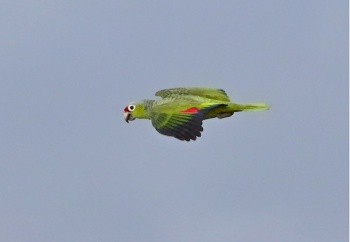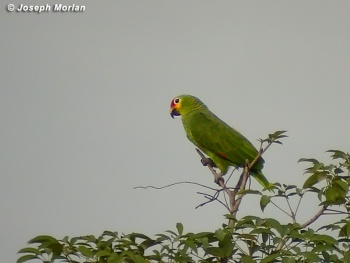Alternative name: Red-lored Amazon
- Amazona autumnalis
Includes: Diademed Amazon or Diademed Parrot
Identification

Photo © by Stanley Jones
Canal Zone, Soberania National Park, Canopy Tower, Semaphore Hill, Panamá Province, Panama, 7 December 2017
31–35 cm (12¼-13¾ in)
- Green overall plumage
- Bright red forehead
- Yellowish cheeks
- Blue crown
- White eye ring
- Green tail with yellow-green and blue tips
- Yellowish-gray bill
- Orange eye
- Greenish-grey legs
Sexes similar.
Juveniles have less yellow on cheeks and less red on forehead.
Similar Species
Red-crowned Parrot has nape and crown red and pale blue only above eyes and on the side of the neck. It also lacks the yellow spot below the eye. The Mealy Parrot has a white eyering and crown with a blue nape. The Yellow-headed Parrot is larger and has a mostly yellow head.
Variations
This species may be divided into three groups. The nominate race found from Mexico to Nicaragua constitutes the "yellow-cheeked" group. Two other races are found to the south constituting the "Salvin's" group. Salvin's types have a darker bill and usually lack the yellow cheek patch. A fourth race, isolated from the others is confined to Brazil and constitutes the "Diademed" group. It has much darker red lores and usually has bluish cheeks. It is sometimes treated as a separate species.

Photo © by Joseph Morlan
Near Sand Hill, Belize, 27 January 2011
Distribution
Resident over almost the entire Caribbean slope to 800m, and on South Pacific slope to 1000m. East Mexico to West Ecuador. Isolated population in Central Brazil.
Introduced to California and Texas.
Taxonomy
Subspecies
Four subspecies are recognized:[1]
- A.a. autumnalis - Caribbean slope, Mexico to northern Nicaragua and Bay Islands
- A.a. salvini - northern Nicaragua to northwestern Ecuador (south to northern Manabí) and extreme northwestern Venezuela (Zulia)
- A.a. lilacina - southwestern Ecuador (north shore of the Bahia de Caráque in central Manabí south to El Oro
- A.a. diadema - northwestern Brazil (lower Rio Negro and northern bank of the upper Amazon)
diadema is sometimes accepted as full species, Diademed Amazon while lilacina has been proposed for full species status, Ecuador Amazon.
Habitat
Humid lowlands and foothills in evergreen and semi-deciduous forests. Common to abundant in partly deforested areas, uncommon in dense mature forest. Ecuador Amazon usually roosts in mangrove flying to coastal dry forest to feed during the day. Observed at heights around 234 m.
Behaviour
A highly social species, they fly in big groups from roosting to feeding sites. When feeding grounds they perch in the tops of trees. They take twigs with fruits with the legs, get the fruits and consume the seeds discarding the rest.
Diet
Their diet consists of palm fruits, figs, nuts and seeds. Also leaves, flower buds and fruits from cultivated plants.
Breeding
They nest in tree cavities. The clutch consists of 3-4 white eggs which are incubated for 25-26 days. Chicks stay in the nest from 21 to 70 days.
Vocalisations
A variety of screeches and calls, most loud, strident and low-pitched calls like kyeik, kyeik, kyeik, etc. yoik,, yoik, yoik; ack-ack or eck-eck, etc
References
- Clements, J. F., T. S. Schulenberg, M. J. Iliff, T. A. Fredericks, J. A. Gerbracht, D. Lepage, S. M. Billerman, B. L. Sullivan, and C. L. Wood. 2022. The eBird/Clements checklist of Birds of the World: v2022. Downloaded from https://www.birds.cornell.edu/clementschecklist/download/
- Gill, F, D Donsker, and P Rasmussen (Eds). 2023. IOC World Bird List (v 13.1)_red. Doi 10.14344/IOC.ML.13.1. http://www.worldbirdnames.org/
- Birdforum thread discussing taxonomy of this species
- Collar, N., Boesman, P. & Kirwan, G.M. (2018). Red-lored Amazon (Amazona autumnalis). In: del Hoyo, J., Elliott, A., Sargatal, J., Christie, D.A. & de Juana, E. (eds.). Handbook of the Birds of the World Alive. Lynx Edicions, Barcelona. (retrieved from https://www.hbw.com/node/54742 on 22 December 2018).
- BF Member observations
- Red-lored Parrot (Amazona autumnalis), In Neotropical Birds Online (T. S. Schulenberg, Editor). Cornell Lab of Ornithology, Ithaca, NY, USA. retrieved from Neotropical Birds Online: https://neotropical.birds.cornell.edu/Species-Account/nb/species/relpar
Recommended Citation
- BirdForum Opus contributors. (2024) Red-lored Parrot. In: BirdForum, the forum for wild birds and birding. Retrieved 30 April 2024 from https://www.birdforum.net/opus/Red-lored_Parrot
External Links
GSearch checked for 2020 platform.1




